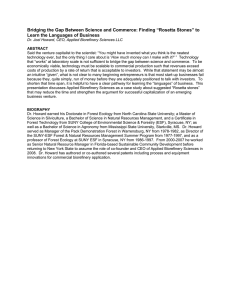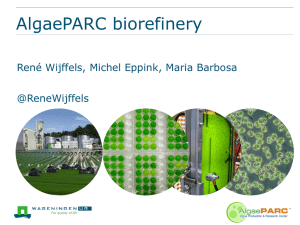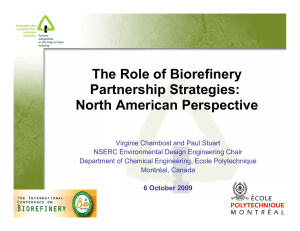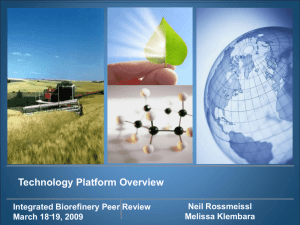Forest Biorefinery Product Portfolio– Selection and Implications to Enterprise Transformation
advertisement
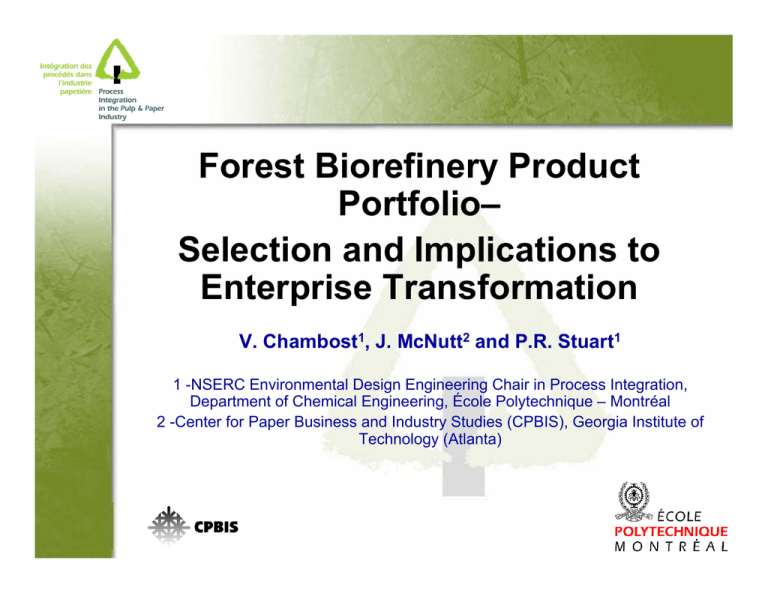
Forest Biorefinery Product Portfolio– Selection and Implications to Enterprise Transformation V. Chambost1, J. McNutt2 and P.R. Stuart1 1 -NSERC Environmental Design Engineering Chair in Process Integration, Department of Chemical Engineering, École Polytechnique – Montréal 2 -Center for Paper Business and Industry Studies (CPBIS), Georgia Institute of Technology (Atlanta) Presentation Outline ¾ Presentation objective ¾ Introduction to key forest biorefinery concepts ¾ Phased approach for forest biorefinery implementation ¾ Value creation via product portfolio definition ¾ Enterprise Transformation and the forest biorefinery ¾ Take-away messages Objective of this presentation A phased-approach for biorefinery implementation is presented, in order to define an appropriate product portfolio likely to be sustainable. The product portfolio selection implicitly defines the Enterprise Transformation needed for the future biorefinery. Presentation Outline ¾ Presentation objective ¾ Introduction to key forest biorefinery concepts ¾ Phased approach for forest biorefinery implementation ¾ Value creation via product portfolio definition ¾ Enterprise Transformation and the forest biorefinery ¾ Take-away messages Some Forest Industry Strategies to Survive and Thrive Go for Survival in Commodities, or Make the Most of Our Existing Industry Buy/Build Elsewhere In Emerging Markets, or Make the Most of Our Pulp and Paper Competency in Emerging Economies To thrive Diversify Core Business with Marketing & Technological Partners, or Make the Most of Our Existing Value Chain by Migration to New Business Paradigms Diminishing Returns Global Competition Forest Biorefinery Forest Biorefinery Definition One forest biorefinery definition: ¾ Full utilization of incoming woody biomass for the production of: Wood products Pulp and paper products Energy Chemicals Another (more practical) forest biorefinery definition: 9 Maximizing the economic value from trees 9 Improved business model 9 Corporate transformation… The Challenge: Evolving to New Business Models While Mitigating Risks Identifying the Right Biorefinery Configuration is Complex… Key Issues to consider for FBR Implementation Company transformation definition and systematic implementation Incremental product implementation strategy across the corporation Biorefinery process design for product diversification and targeted return on investment Presentation Outline ¾ Presentation objective ¾ Introduction to key forest biorefinery concepts ¾ Phased approach for forest biorefinery implementation ¾ Value creation via product portfolio definition ¾ Enterprise Transformation and the forest biorefinery ¾ Take-away messages Some Key Competitive Factors Main competitive advantages for forestry companies: Access to biomass availability and harvesting knowhow Existing infrastructure in close proximity to forest biomass Established supply chain for wood, pulp and paper products Main competitive disadvantages for forestry companies: Lack of capital Lack of product development culture Lack of knowledge of product quality requirement, supply chain practices, etc. for new bioproducts Strategic Approach for Implementing the Biorefinery Implementation: compete with all capital spending Phase I Lower Operating Costs Replace fossil fuels at mill (natural gas, Bunker C), and/or Produce “building block” chemical Minimum risk technologies s Compete ge n e l l a internally for capital ch n i a M Phase II Increase Revenues: Exportable green energy, and/or Manufacture of derivatives Market development for new products Higher process complexity and technology risk Partners essential Select the most sustainable product platform and partner(s) Phase III Improve Margins: Knowledge-based manufacturing and production flexibility Business flow transformation Product development culture Off-shoring, Outsourcing, etc… Company culture transformation Supply Chain Management key to success Strategic Vision: Phase II must determine Phase I & III Strategic Approach for Implementing the Biorefinery Implementation: compete with all capital spending Phase I Lower Operating Costs: Replace fossil fuels at mill (natural gas, Bunker C), and/or Produce “building block” chemical Minimum risk technologies Phase II Increase Revenues: Exportable green energy, and/or Manufacture of derivatives Market development for new products Higher process complexity and technology risk Partners essential Phase III Improve Margins: Knowledge-based manufacturing and production flexibility Business flow transformation Product development culture Off-shoring, Outsourcing, etc… Margins Improvements Strategic Vision: Phase II must determine Phase I & III Presentation Outline ¾ Presentation objective ¾ Introduction to key forest biorefinery concepts ¾ Phased approach for forest biorefinery implementation ¾ Value creation via product portfolio definition ¾ Some definitions ¾ Approach for building a product portfolio ¾ Enterprise Transformation and the forest biorefinery ¾ Take-away messages Forest biorefinery Value Resides in the Product Portfolio Phase 3 Phase 2 Phase 1 The product portfolio is the enabler for value creation and should be strategically determined to achieve value over the longer term The product portfolio strategy is the basis for process selection and business strategy definition required for value optimization How should the product portfolio be selected and designed in order to support a sustainable business plan? – is the key question Products derived from Biomass Opportunities Forest Biorefinery Product Family Waste Chips Biomass Pulp and Paper Mill Co-products or wastes? Yield? Building Block Yield? Yield? Derivative Deriva tive P&P Products $$ Main Biorefinery Products to Market $$$$ Reducing Volumes, Flexible Throughputs… Increasing Process Complexity Product Portfolio Definition Value Chains need to be considered for long term biorefinery sustainability: o Production flexibility = market flexibility (supply/demand) o Unique supply chain is key for competitive position in the longer term o Margins stability and risk mitigation challenges are addressed while diversifying the product portfolio Presentation Outline ¾ Presentation objective ¾ Introduction to key forest biorefinery concepts ¾ Phased approach for forest biorefinery implementation ¾ Value creation via product portfolio definition ¾ Some definitions ¾ Approach for building a product portfolio ¾ Enterprise Transformation and the forest biorefinery ¾ Take-away message Process-Centric and Product-Centric Design “Towards a Product-Centered Chemical Industry - Rethinking the Role of R&D and its Interaction with Marketing and Business Strategy” FOCAPD (2004) George Stephanopoulos, MIT Chemical Engineering is moving from being processcentric to product-centric, for example DuPont’s ‘Rapid Market Analysis’ as starting point for product-centric activities Product centered: market trends Æ product specifications Æ components and subsystems Æ chemicals and materials Æ manufacturing systems design Some Lessons Learned Thus Far… Biorefinery technology will be critical for competitive position in the short-term, the unique supply chain will be essential for competitive position in the longer-term In order to be competitive in the longer term: product design for the product portfolio must precede process design To minimize risks and ensure successful business development requires partnering along the value chain To mitigate against market price volatility requires designing for manufacturing flexibility The key to success in the forest biorefinery will be through implementing “knowledge-based manufacturing” along with flexible manufacturing supported by advanced supply chain management Technology Push/Market Pull considerations: critical overview cts u d o t pr we a h W ld cou acture? 4 uf man EL 200 NR . g . e Innovation Novel product Wha t sho produc man uld w ts e.g. ufactur e e? Pen ner 200 6 Substitution Technology Push Process-centric design Market Pull Substitution Replacement Product-centric design Adaptation NREL Approach for Defining Promising Biorefinery Chemicals NREL, Top 10 Value Added Chemicals, 2004 Carbohydrate Platform Technology Push ? ? Petrochemical Value Chain Analysis Greg Penner, Top 7, Industry Canada, Jan. 2007 Biorefinery Platform Market Pull ? ? ? ? Technology Push/Market Pull considerations: critical overview ucts d o r t p we a h W ld cou acture? uf 04 n 0 a 2 m REL N . e.g Innovation Novel product The most appropriate choice for a company Technology Push Process-centric design Wha t sho product man uld w s e.g. ufactur e e? Pen ner 200 Substitution 6 Substitution Market Pull Replacement Product-centric design Adaptation Product Portfolio Definition: Which Biorefinery Sequence? Product family analysis: Creating added value along the value chain What are the competitive factors associated with the aggregated product family? Individual Product Analysis Which replacement/substitution products should be considered? Promising technologies Product growth Potential for competitive advantage with green product Competitive manufacturing costs/existing value chain Risks? Product Portfolio: What potential new supply chain opportunities are there? Will a unique supply chain result, that can’t be achieved by others? Risks? Risks? Partnership Selection: Who are the promising partners for the candidate product families? Do their corporate visions align with yours, i.e. implementing the biorefinery in partnership? Key issues Multiproduct strategy and its implementation are critical for the success with the biorefinery, and imply changes in the core business This must therefore be complemented with the systematic analysis of the implied and essential Enterprise Transformation Presentation Outline ¾ Presentation objective ¾ Introduction to key forest biorefinery concepts ¾ Phased approach for forest biorefinery implementation ¾ Value creation via product portfolio definition ¾ Enterprise Transformation and the forest biorefinery ¾ Take-away messages Enterprise Transformation: Definitions Enterprise Transformation is considered as a core strategy for other industries and companies, to create sustainable profitability 2 transformation concepts: ‘Inside-out’: • Improve bottom-line results via transforming the enterprise by changing processes within the existing organization, including changes in manufactured products • Current vision, mission and strategies are maintained ‘Outside-in’: • Core vision, mission and strategies are changed to create a newly focused to the outside market that is sustainable with vastly improved bottom-line results ¾ Transformation to the forest biorefinery implies potential for both types of transformation Inside-Out Transformation -- GP Under Koch Industries ownership – GP essentially pursuing past market place directed focuses ~ Similar or identical products and services delivered to essentially same marketplace & customer base. GP reworking details on how to function to deliver same basket of goods & services to the market place better, more profitably, & more sustainable Outside-In Transformation – UPS Alternatively – outside the paper industry ~ UPS (now “Big Brown”) has pursued an Outside-In transformation ~ UPS adopted entirely new vision & mission. Once the leading long distance package shipping/handling firm globally – UPS concluded standing pat would assure a slow decline in sustainability & profitability To assure a sustainable & profitable long term existence, UPS morphed to a major supply chain services organization with an entirely new reason for existence. Outside-In Transformation – Potlatch Another firm following an Outside-in transformation in the forest products industry space is Potlatch ~ Once vertically/horizontally integrated producer driven by mix of paper & solid wood products delivered to a defined marketplace and customer base ~ Potlatch altered its entire macro reason for existence by transforming itself into a Real Estate Investment Trust (or a “REIT”) Now driven by totally new mission/vision focused first on timber/timberland returns at the core – resulting in major transformation of key ways Potlatch now operates from the inside out Where in a way Potlatch did create an Inside-Out transformation but one driven at the heart by a comprehensive “Outside-in” transformation Can P&P Companies adopt this Culture? Core business transformation, by product portfolio adjustments related to market evolutions. Proactivity is critical enabler for successful enterprise transformation 3 204 Years of Innovation Cyclical adaptation to reinvent the business and transform the enterprise, while avoiding declining activities. Maturity Maturity Maturity Growth Growth Birth Growth Birth Birth Chemistry, Energy Chemistry, Biology, Materials Science Explosives Biorefinery opportunity for pulp and paper industry 19 Sept 06 1802 1830 1850 1900 1925 1945 1990 2000 2050 2090 Strategic Approach for Implementing the Biorefinery Implementation: compete with all capital spending Phase I Lower Operating Costs: Replace fossil fuels at mill (natural gas, Bunker C), and/or Produce “building block” chemical Minimum risk technologies Phase II Increase Revenues: Exportable green energy, and/or Manufacture of derivatives Market development for new products Higher process complexity and technology risk Partners essential Phase III Improve Margins: Knowledge-based manufacturing and production flexibility Business flow transformation Product development culture Off-shoring, Outsourcing, etc… Margins improve with Enterprise Transformation Strategic Vision: Phase II must determine Phase I & III Presentation Outline ¾ Presentation objective ¾ Introduction to key forest biorefinery concepts ¾ Phased approach for forest biorefinery implementation ¾ Value creation via product portfolio definition ¾ Enterprise Transformation and the forest biorefinery ¾ Take-away messages Take-Away Messages The definition of a strategic product portfolio is critical for the success of the biorefinery and the related industry transformation It is a strategic task that implies product-centric analyses as well as process design and key considerations on supply chain definitions and partnership strategies The definition of the biorefinery product portfolio needs to be considered simultaneously from a market and a technical perspective The transformation to the forest biorefinery resides in the phased implementation enabling the shift between an inside-out to an inside-in transformation Take-Away Messages Various companies have been successful at transformation, but this is less obvious for pulp and paper companies Both inside-out and outside-in transformation types are essential for biorefinery implementation Product portfolio management, and changes in this, imply the transformation is needed and as well: Processes implied Unique supply chain for long-term competitive advantage Supply chain synergies that can be realized Appropriate biorefinery partners A methodology is needed for specific companies to identify their strategy This should be used to define a practical and phased implementation for the biorefinery at a given company Thank You! Forest Biorefinery Product Portfolio– Selection and Implications to Enterprise Transformation V. Chambost, J. McNutt and P.R. Stuart
